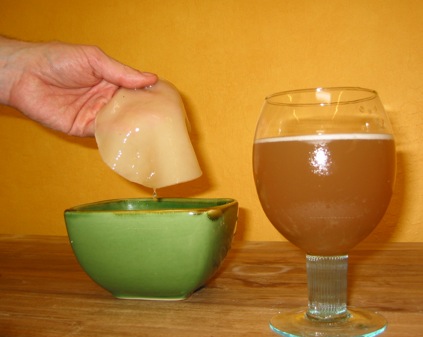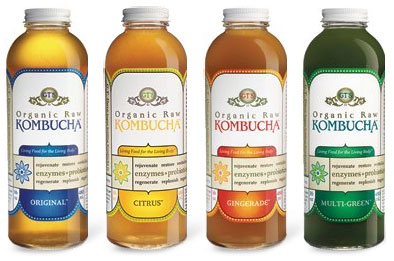Hey guys, you know what I could totally go for right now? A cloudy liquid with an unattractive, brown and squishy mushroom floating in it. Mmmmm.
Let me introduce you to kombucha (pronounced kom-BOO-cha).

What is kombucha and where did it come from?
Kombucha wasn’t discovered growing in a magical forest. Rather, the kombucha culture was concocted, either on purpose or accidentally, around 220 BC. Since the liquid base of the kombucha brew is tea, experts suggest that it originated close to China.
It’s thought that the name “kombucha” came from the Japanese word for seaweed – kombu. Others say that the beverage was developed by a fellow named Dr. Kombu.
While the brew has been around for centuries, kombucha didn’t gain popularity until the early 1900s. Soviet leader Josef Stalin went on a quest to avoid cancer, which led him to kombucha. This consequently increased the attractiveness of the drink. (It’s hard to imagine Stalin being a compelling spokesperson in 2009, but maybe he’d be less annoying than Vince the ShamWow guy.)
Kombucha is produced by the fermentation of tea and sugar along with bacteria and yeasts forming a “tea fungus.” While green tea can be used, black tea and white sugar seem to work best.
Here’s a summary of how kombucha is prepared:
- Tea is steeped
- Sugar is added to hot tea, then the tea is cooled
- Vinegar or existing kombucha brew is added
- Tea fungus is put in tea
- Tea mix is put into a jar and covered
- Incubated at room temp for 7-10 days (it can ferment for longer than 10 days, but acid levels must be regulated)
- The beverage is passed through a cheesecloth and collected
- During fermentation the taste changes – it’s often compared to carbonated apple cider
What you should know about kombucha
The kombucha culture is a collection of yeast and bacteria encased in cellulose. It’s generally shaped like a large pancake and is slippery and flexible when touched. Kombucha is a living, growing organism and is actually quite similar to cultures that activate yogurt and transform cabbage into sauerkraut.
Yeast and bacteria
Let’s talk about yeast and bacteria, our fermentation friends.
Yeasts are simple fungi, one cell in size. Kombucha yeasts will “bud” rather than scatter spores to reproduce. Yeasts contain vitamins, minerals, sterols and proteins.
Yeast can be found just about anywhere you find carbohydrates. The more carbs around, the quicker they reproduce.
As they digest sugars, yeasts give off CO2, which makes bread rise and kombucha brew fizzy. They can also help in the fermentation of grain. You might be familiar with beer (usually from barley) and sake (from rice).
In kombucha, what yeasts start, bacteria finish. When yeasts break down sugar in kombucha, they leave behind ethanol, B vitamins, CO2, and acids — all exactly what the bacteria need.
Bacteria eat ethanol and leave behind acids, similar to vinegar production (but vinegar production usually doesn’t incorporate yeast). Fermentation bacteria also love sugar and B vitamins along with ethanol, so they are great for digesting yeast by-products.
The role of friendly bacteria
Although the makers of disinfectants would probably have us believe otherwise, bacteria aren’t always bad. For instance:
- This one-two yeast-bacteria fermentation process is also used in the manufacture of many types of wine.
- Fermented tempeh, soy sauce, cheese, yogurt, and vinegar all contain bacteria.
- Bacteria can also change your compost pile into a heap of organic material for growing new veggies.
- And you are pretty much a container for zillions of friendly microbes all over your body and in your digestive tract.
There is a lot of evidence that consuming bacterially fermented foods — or even just straight-up friendly bacteria, as in the case of a probiotic supplement — is good for us.
However, we don’t know for sure whether kombucha actually falls into this “good for us” category.
Fermentation
If yeast and bacteria are sitting alone with nothing around, they’ll starve. When you give them nourishment, like black tea and sugar, the process begins.
The main components in the final brew include:
Ethanol
About 0.5%. By comparison, regular beer generally has about 5%.
Ethanol and acetic acid have been reported to have antimicrobial activity against pathogenic bacteria, which can provide protection against kombucha brew contamination.
The alcohol content in raw kombucha brew can increase after bottling. Sometimes it can reach levels of 2 to 5%.
Carbon dioxide/carbonic acid
This carbonates kombucha brew, making it fizzy.
Sugar
Added to feed yeasts and bacteria.
Vitamins
Left behind when yeasts break down sugars, mainly B and C vitamins.
Acetic acid
This stuff is regarded as healthy, but if left sitting too long it can react with alcohol and form acetates. Those shouldn’t be consumed. If your kombucha ever smells like acetone, you don’t want to drink it. Acetic acid is also found in vinegar.
Lactic acid
This is a byproduct of the fermentation process. It might have a laxative effect.
Lactase & invertase
Enzymes that break down sugars.
Acids (including amino, gluconic, glucuronic, usnic, others)
Gluconic acid acts as a preservative and is thought to function in the liver as a detoxification agent.
Usnic acid may deactivate groups of viruses, but the actual content in kombucha hasn’t been confirmed.
Glucuronic acid may help to bind toxins and eliminate them. Some data revealed that kombucha brew might not even contain glucuronic acid, rather 2-keto-gluconic acid.
Duh. Easy mistake.
Caffeine
Small amount from tea.
Cellulose
If you ever see little particles in kombucha brew, it’s likely bits of cellulose.
Most kombucha beverages will have additions for flavor. Ginger, fruit juice, and herbs are common.
Remember that tea is the medium in which kombucha is produced. The health benefits of tea have been studied in depth. For more on tea, see What You Should Know About Tea.
Why is kombucha so important?
Kombucha sells for about $3 per bottle and annual sales may soon hit the $100 million mark.

In the mid-1900s various studies indicated beneficial effects from kombucha consumption, but the methodology remains unclear. In the 1950s, it was said that kombucha might contribute to cancer, which didn’t help its reputation.
In the late 1900s, as more people sought alternative approaches to disease prevention, kombucha became common again.
Alleged benefits
The health effects of drinking kombucha are based largely on drinker testimony and the companies selling it.
After reading the list below, you may wonder when “bigger paycheck”, “increased attractiveness”, and “ability to levitate” will be added.
According to testimonials, kombucha brew can:
- Detoxify the body
- Reduce cholesterol
- Reduce atherosclerosis
- Reduce blood pressure
- Reduce inflammatory problems
- Alleviate arthritis, rheumatism and gout symptoms
- Promote liver function
- Normalize intestinal activity, balance intestinal flora, and cure hemorrhoids
- Reduce obesity, regulate appetite, enhance metabolism
- Prevent/heal bladder infection and reduce kidney calcification
- Stimulate the glandular system
- Protect against diabetes
- Increase resistance to cancer, counteract aging problems
- Antibiotic effect against bacteria, viruses and yeasts
- Enhance the immune system
- Relieve bronchitis and asthma
- Reduce menstrual disorders and menopausal hot flashes
- Improve hair, skin and nail health
- Reduce craving for alcohol
- Reduce stress and nervous disturbances, headaches, insomnia
- Improve eyesight
Pretty impressive list. And almost entirely unsubstantiated in clinical research.
Side effects and toxicity
Kombucha isn’t all fun.
There have been reports of stomach upset, allergic reactions, kidney problems, liver toxicity, skin disease, and metabolic acidosis.
When kombucha is prepared at home, there is a very real possibility of contamination by pathogenic bacteria and yeasts. Preparing kombucha in a non-glass container can leach toxic elements, like lead, into the final beverage. Not good.
Makers of kombucha say that its production in the commercial setting is safe when kept raw, and pasteurization should be avoided since it will destroy beneficial bacteria. That’s true, but pasteurization also kills dangerous bacteria. Other beneficial compounds in kombucha are preserved in both raw and pasteurized products.
How much?
Starting with small amounts of kombucha brew consumption is recommended, no more than 4 ounces per day. Maximum intake would be no more than 16 ounces per day.
Summary and recommendations
There are no well-documented uses for kombucha tea. The benefits might simply be due to increased tea consumption.
If you take up the kombucha habit, exercise caution, since the risk to benefit ratio is fairly even. Drinking small amounts (4 to 8 ounces) of kombucha from reputable distributors seems to be fine. Still, research is extremely limited, so sip with caution.
Water, water with lemon, and regular tea seem to be the healthiest beverage options.
Extra credit
The FDA has noted concerns about the possibility of kombucha contamination by fungi, such as Aspergillus and Candida sp., known to cause disease in susceptible individuals.
There is one reported case of anthrax from using kombucha topically.
Some may have an allergic reaction to kombucha.
Other common fermented items include sauerkraut, pickles, soy sauce, beer, yogurt and cheese.
Kombucha has been referred to as the “remedy for immortality.”
In rats, kombucha brew may reduce pain and improve sleep.
Kombucha toxicity seems to vary from species to species.
About my kombucha literature search:
A search on Pubmed, the database of clinical research, for “kombucha” yielded 38 results. When I flipped on the “human only” limit switch, the total dropped to 15. Let me tell you, perusing the article titles, nothing looked too positive.
Remember your old stats prof’s proverb: The plural of “anecdote” is not “data”.
References
Click here to view the information sources referenced in this article.
Learn more
Want to get in the best shape of your life, and stay that way for good? Check out the following 5-day body transformation courses.
The best part? They're totally free.
To check out the free courses, just click one of the links below.



Share